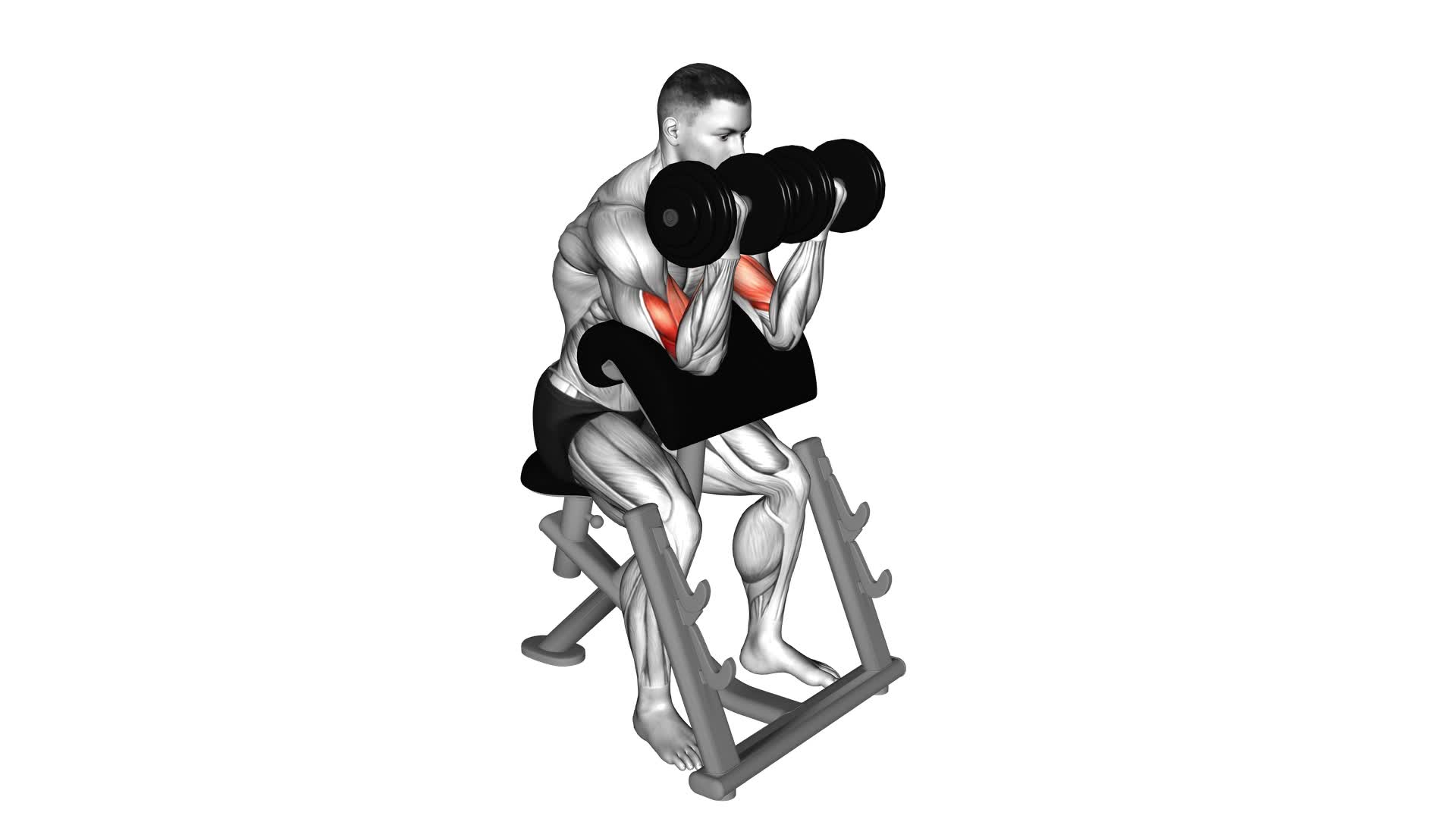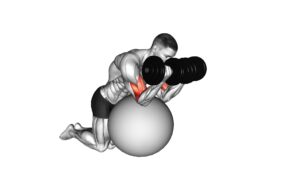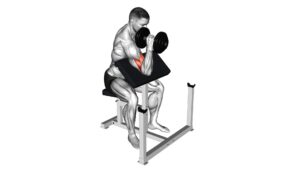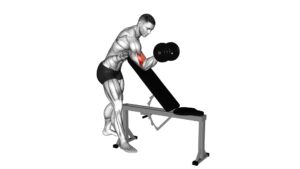Dumbbell Seated Preacher Curl – Video Exercise Guide & Tips

Looking to build strong biceps?
Watch This Exercise Video
The dumbbell seated preacher curl is the exercise for you. In this video guide, we'll show you the proper form and technique to maximize your gains.
Whether you're a beginner or a seasoned lifter, we've got variations and modifications to suit your fitness level.
Avoid common mistakes and get expert tips on incorporating this exercise into your workout routine.
Get ready to flex those muscles and watch them grow!
Key Takeaways
- Targets the biceps for increased muscle activation
- Provides a greater range of motion and muscle fiber recruitment
- Eliminates momentum and swinging, reducing the risk of injury
- Enhances mind-muscle connection for focused contraction
Benefits of the Dumbbell Seated Preacher Curl
You can experience a range of benefits by incorporating the dumbbell seated preacher curl into your workout routine. This exercise specifically targets the biceps, leading to increased muscle activation. When performing the dumbbell seated preacher curl, your biceps are in a fully stretched position at the bottom of the movement, allowing for a greater range of motion and increased muscle fiber recruitment.
Compared to other bicep exercises like the standing barbell curl or the hammer curl, the dumbbell seated preacher curl offers unique advantages. Firstly, the preacher curl isolates the biceps by eliminating any momentum or swinging of the body. This ensures that the biceps are the primary muscles being worked and reduces the risk of injury. Additionally, the preacher curl allows for a greater mind-muscle connection as you focus solely on contracting the biceps throughout the movement.
Moreover, the seated position in the preacher curl provides stability and support, allowing you to lift heavier weights and challenge your muscles further. This can lead to increased strength and muscle growth over time. The dumbbell variation of the seated preacher curl also allows for unilateral training, helping to correct any muscle imbalances between the left and right biceps.
Incorporating the dumbbell seated preacher curl into your workout routine can be a valuable addition to your bicep training. It effectively targets the biceps, offers unique advantages compared to other exercises, and allows for progressive overload.
Proper Form and Technique for the Exercise
To perform the dumbbell seated preacher curl with proper form and technique, ensure that your elbows are positioned firmly against the preacher bench. This exercise is highly effective for targeting the biceps and can provide numerous benefits. One of the key benefits of the dumbbell seated preacher curl is its ability to isolate the biceps, allowing for a more focused and intense workout. By keeping your elbows against the bench, you prevent any swinging or momentum, ensuring that the biceps are doing all the work. Additionally, this exercise helps to improve grip strength and forearm stability.
When performing the dumbbell seated preacher curl, it's important to maintain proper form throughout the movement. Start by sitting on the preacher bench with your feet flat on the floor and your back straight. Grasp the dumbbells with an underhand grip and allow your arms to fully extend towards the floor. Slowly curl the dumbbells towards your shoulders, squeezing the biceps at the top of the movement. Lower the dumbbells back down in a controlled manner to complete one repetition.
To maximize the benefits of the dumbbell seated preacher curl, incorporate it into your regular workout routine. Aim for 3-4 sets of 10-12 repetitions, using a weight that challenges your muscles but still allows for proper form. Remember to warm up before starting and stretch afterward to prevent any injuries.
Transition: Now that you understand the proper form and technique for the dumbbell seated preacher curl, let's explore some variations and modifications for different fitness levels.
Variations and Modifications for Different Fitness Levels
Now let's explore some variations and modifications to cater to different fitness levels when performing the dumbbell seated preacher curl. If you're a beginner, there are a few modifications you can make to ease into this exercise. First, you can start by using lighter dumbbells or even just your body weight. This will help you focus on getting the proper form and technique before progressing to heavier weights.
Another modification is to perform the exercise seated on a stability ball instead of a bench. This will engage your core muscles and add an extra challenge to the exercise.
For those who are more advanced, there are several variations you can try to increase the intensity of the dumbbell seated preacher curl. One option is to use a resistance band in addition to the dumbbells. This will add constant tension to the biceps throughout the movement.
Another variation is to perform the exercise using an EZ bar instead of dumbbells. The curved shape of the bar allows for a different grip and can target the biceps from a slightly different angle.
Lastly, you can try doing the seated preacher curl with one arm at a time instead of both arms simultaneously. This will challenge your stability and allow for greater focus on each individual arm. Remember to always listen to your body and choose the variation or modification that suits your fitness level best.
Common Mistakes to Avoid While Performing the Exercise
When performing the dumbbell seated preacher curl, it's important to be aware of common mistakes that can hinder your progress and potentially lead to injury. To ensure that you're performing the exercise correctly and safely, here are some mistakes to avoid and tips for proper technique:
- Using too much weight: One common mistake is selecting a weight that's too heavy. This can compromise your form and increase the risk of injury. Start with a weight that allows you to maintain proper form throughout the exercise.
- Swinging the body: Another mistake is using momentum to lift the weight instead of relying on the targeted muscles. To avoid this, keep your upper arms stationary and only move your forearms while performing the curl.
- Not maintaining proper posture: It's crucial to maintain proper posture throughout the exercise. Avoid arching your back or slouching forward, as this can strain your lower back. Keep your back straight and engage your core for stability.
- Neglecting the full range of motion: Make sure to fully extend your arms at the bottom of the movement and squeeze your biceps at the top. Neglecting the full range of motion can limit the effectiveness of the exercise.
By avoiding these common mistakes and focusing on proper technique, you can maximize the benefits of the dumbbell seated preacher curl and reduce the risk of injury.
Now, let's move on to the next section to learn some tips for incorporating this exercise into your workout routine.
Tips for Incorporating the Dumbbell Seated Preacher Curl Into Your Workout Routine
To incorporate the dumbbell seated preacher curl into your workout routine, start by selecting a weight that challenges your muscles without compromising your form. The seated preacher curl is an effective exercise for targeting the biceps and building upper arm strength. It provides several benefits, such as isolating the biceps, reducing the involvement of other muscles, and allowing for strict form and controlled movements.
One of the best dumbbell exercises for biceps, the seated preacher curl can be incorporated into your routine in a few simple steps. Begin by sitting on a preacher bench with your feet flat on the floor and your arms fully extended, holding a dumbbell in each hand. Keep your upper arms flat against the pad and curl the dumbbells towards your shoulders, squeezing your biceps at the top of the movement. Slowly lower the weights back down to the starting position and repeat for the desired number of repetitions.
To maximize the effectiveness of this exercise, focus on maintaining proper form throughout the movement. Keep your back straight, engage your core, and avoid using momentum to lift the weights. It's also important to control the eccentric (lowering) phase of the exercise to fully engage the biceps.
Frequently Asked Questions
How Much Weight Should I Use for the Dumbbell Seated Preacher Curl?
To determine how much weight you should use for the dumbbell seated preacher curl, consider your current strength level and goals.
Start with a weight that challenges you but allows you to maintain proper form.
Gradually increase the weight as you get stronger.
Remember, the key is to perform the exercise with proper technique to target the biceps effectively.
If done correctly, the dumbbell seated preacher curl can help build muscle and improve arm strength.
Can I Perform the Dumbbell Seated Preacher Curl Using a Barbell Instead?
Yes, you can perform the dumbbell seated preacher curl using a barbell instead. However, it's important to note that the dumbbell seated preacher curl offers unique benefits.
With dumbbells, each arm works independently, which helps improve muscle balance and stability. Additionally, dumbbells allow for a greater range of motion, targeting the biceps more effectively.
How Often Should I Include the Dumbbell Seated Preacher Curl in My Workout Routine?
To determine the workout frequency for the dumbbell seated preacher curl, it's important to consider proper form and muscle recovery.
This exercise primarily targets the biceps, so you can include it in your routine 2-3 times a week, with at least one day of rest in between.
Remember to maintain a stable seated position, keep your elbows on the pad, and perform the movement in a controlled manner to maximize results and minimize the risk of injury.
Are There Any Alternative Exercises That Target the Same Muscles as the Dumbbell Seated Preacher Curl?
Looking for alternative exercises that target the same muscles as the dumbbell seated preacher curl? There are a few options you can try.
One alternative is the hammer curl, which works your biceps in a similar way.
Another option is the cable bicep curl, which provides resistance from a different angle.
Lastly, you can try the incline dumbbell curl, which targets your biceps while also engaging your shoulders and upper chest.
Give these exercises a shot to switch up your routine!
Can I Do the Dumbbell Seated Preacher Curl if I Have a Shoulder Injury?
If you have a shoulder injury, you may want to reconsider doing the dumbbell seated preacher curl. While this exercise can be beneficial for shoulder strength and stability, it can also put strain on the injured area.
It's important to prioritize your recovery and avoid any movements that cause pain or discomfort. Consult with a medical professional or physical therapist for alternative exercises that target the same muscles without exacerbating your shoulder injury.
Conclusion
The dumbbell seated preacher curl is a great exercise for targeting the biceps and building upper arm strength. By maintaining proper form and technique, you can maximize the benefits of this exercise.
There are variations and modifications available to accommodate different fitness levels. However, it's important to avoid common mistakes to prevent injury.
Incorporating the dumbbell seated preacher curl into your workout routine can help you achieve stronger and more defined arms.

Author
Years ago, the spark of my life’s passion ignited in my mind the moment I stepped into the local gym for the first time. The inaugural bead of perspiration, the initial endeavor, the very first surge of endorphins, and a sense of pride that washed over me post-workout marked the beginning of my deep-seated interest in strength sports, fitness, and sports nutrition. This very curiosity blossomed rapidly into a profound fascination, propelling me to earn a Master’s degree in Physical Education from the Academy of Physical Education in Krakow, followed by a Sports Manager diploma from the Jagiellonian University. My journey of growth led me to gain more specialized qualifications, such as being a certified personal trainer with a focus on sports dietetics, a lifeguard, and an instructor for wellness and corrective gymnastics. Theoretical knowledge paired seamlessly with practical experience, reinforcing my belief that the transformation of individuals under my guidance was also a reflection of my personal growth. This belief holds true even today. Each day, I strive to push the boundaries and explore new realms. These realms gently elevate me to greater heights. The unique combination of passion for my field and the continuous quest for growth fuels my drive to break new ground.







